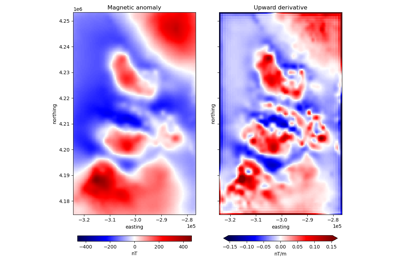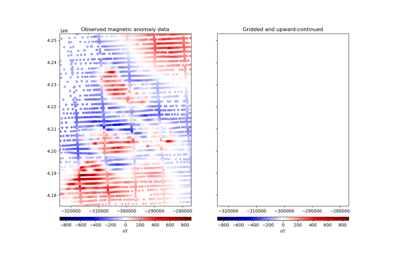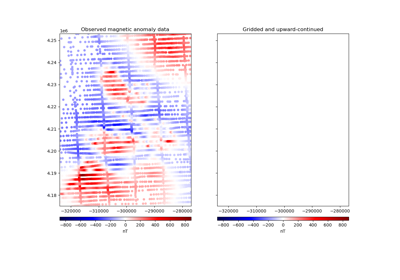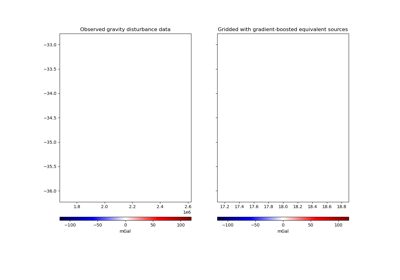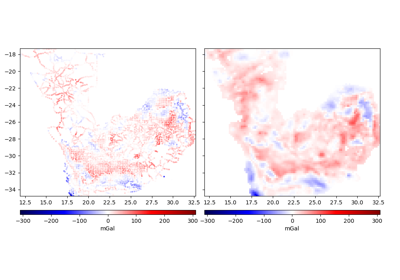harmonica.EquivalentSources
Contents
harmonica.EquivalentSources¶
- class harmonica.EquivalentSources(damping=None, points=None, depth=500, depth_type='relative', block_size=None, parallel=True, dtype='float64', **kwargs)[source]¶
Equivalent sources for generic harmonic functions (gravity, magnetics).
These equivalent sources can be used for:
Cartesian coordinates (geographic coordinates must be project before use)
Gravity and magnetic data (including derivatives)
Single data types
Interpolation
Upward continuation
Finite-difference based derivative calculations
They cannot be used for:
Regional or global data where Earth’s curvature must be taken into account
Joint inversion of multiple data types (e.g., gravity + gravity gradients)
Reduction to the pole of magnetic total field anomaly data
Analytical derivative calculations
By default, the point sources are located beneath the observed potential-field measurement points [Cooper2000] that are passed as arguments to the
EquivalentSources.fitmethod, producing the same number of sources as data points. Alternatively, we can reduce the number of sources by using block-averaged sources [Soler2021]: we divide the data region in blocks of equal size and compute the median location of the observations points that fall under each block. Then, we locate one point source beneath each one of these locations. The size of the blocks, that indirectly controls how many sources will be created, can be specified through theblock_sizeargument. We recommend choosing ablock_sizeno larger than the resolution of the grid where interpolations will be carried out.The depth of the sources can be controlled by the
depthargument. Ifdepth_typeis set to"relative", then each source is located beneath each data point or block-averaged location at a depth equal to its elevation minus the value of thedepthargument. Ifdepth_typeis set to"constant", then every source is located at a constant depth given by thedepthargument. In both cases a positive value ofdepthlocates sources _beneath_ the data points or the block-averaged locations, thus a negativedepthwill put the sources _above_ them.Custom source locations can be chosen by specifying the
pointsargument, in which case thedepth_type,block_sizeanddeptharguments will be ignored.The corresponding coefficient for each point source is estimated through linear least-squares with damping (Tikhonov 0th order) regularization.
The Green’s function for point mass effects used is the inverse Euclidean distance between the observation points and the point sources:
\[\phi(\bar{x}, \bar{x}') = \frac{1}{||\bar{x} - \bar{x}'||}\]where \(\bar{x}\) and \(\bar{x}'\) are the coordinate vectors of the observation point and the source, respectively.
- Parameters
damping (None or float) – The positive damping regularization parameter. Controls how much smoothness is imposed on the estimated coefficients. If None, no regularization is used.
points (None or list of arrays (optional)) – List containing the coordinates of the equivalent point sources. Coordinates are assumed to be in the following order: (
easting,northing,upward). If None, will place one point source below each observation point at a fixed relative depth below the observation point [Cooper2000]. Defaults to None.depth (float) – Parameter used to control the depth at which the point sources will be located. If
depth_typeis"constant", each source is located at the same depth specified through thedepthargument. Ifdepth_typeis"relative", each source is located beneath each data point (or block-averaged location) at a depth equal to its elevation minus thedepthvalue. This parameter is ignored if points is specified. Defaults to 500.depth_type (str) – Strategy used for setting the depth of the point sources. The two available strategies are
"constant"and"relative". This parameter is ignored if points is specified. Defaults to"relative".block_size (float, tuple = (s_north, s_east) or None) – Size of the blocks used on block-averaged equivalent sources. If a single value is passed, the blocks will have a square shape. Alternatively, the dimensions of the blocks in the South-North and West-East directions can be specified by passing a tuple. If None, no block-averaging is applied. This parameter is ignored if points are specified. Default to None.
parallel (bool) – If True any predictions and Jacobian building is carried out in parallel through Numba’s
jit.prange, reducing the computation time. If False, these tasks will be run on a single CPU. Default to True.dtype (data-type) – The desired data-type for the predictions and the Jacobian matrix. Default to
"float64".
- Variables
References
Methods Summary
|
Filter the data through the gridder and produce residuals. |
|
Fit the coefficients of the equivalent sources. |
|
Get parameters for this estimator. |
|
Interpolate the data onto a regular grid. |
|
Make the Jacobian matrix for the equivalent sources. |
|
Evaluate the estimated equivalent sources on the given set of points. |
|
Interpolate data along a profile between two points. |
|
|
|
Score the gridder predictions against the given data. |
|
Set the parameters of this estimator. |
- EquivalentSources.filter(coordinates, data, weights=None)¶
Filter the data through the gridder and produce residuals.
Calls
fiton the data, evaluates the residuals (data - predicted data), and returns the coordinates, residuals, and weights.No very useful by itself but this interface makes gridders compatible with other processing operations and is used by
verde.Chainto join them together (for example, so you can fit a spline on the residuals of a trend).- Parameters
coordinates (tuple of arrays) – Arrays with the coordinates of each data point. Should be in the following order: (easting, northing, vertical, …). For the specific definition of coordinate systems and what these names mean, see the class docstring.
data (array or tuple of arrays) – The data values of each data point. If the data has more than one component, data must be a tuple of arrays (one for each component).
weights (None or array or tuple of arrays) – If not None, then the weights assigned to each data point. If more than one data component is provided, you must provide a weights array for each data component (if not None).
- Returns
coordinates, residuals, weights – The coordinates and weights are same as the input. Residuals are the input data minus the predicted data.
- EquivalentSources.fit(coordinates, data, weights=None)[source]¶
Fit the coefficients of the equivalent sources.
The data region is captured and used as default for the
gridmethod.All input arrays must have the same shape.
- Parameters
coordinates (tuple of arrays) – Arrays with the coordinates of each data point. Should be in the following order: (
easting,northing,upward, …). Onlyeasting,northing, andupwardwill be used, all subsequent coordinates will be ignored.data (array) – The data values of each data point.
weights (None or array) – If not None, then the weights assigned to each data point. Typically, this should be 1 over the data uncertainty squared.
- Returns
self – Returns this estimator instance for chaining operations.
- EquivalentSources.get_params(deep=True)¶
Get parameters for this estimator.
- Parameters
deep (bool, default=True) – If True, will return the parameters for this estimator and contained subobjects that are estimators.
- Returns
params (dict) – Parameter names mapped to their values.
- EquivalentSources.grid(coordinates, dims=None, data_names=None, projection=None, **kwargs)[source]¶
Interpolate the data onto a regular grid.
The coordinates of the regular grid must be passed through the
coordinatesargument as a tuple containing three arrays in the following order:(easting, nothing, upward). They can be easily created through theverde.grid_coordinatesfunction. If the grid points must be all at the same height, it can be specified in theextra_coordsargument ofverde.grid_coordinates.Use the dims and data_names arguments to set custom names for the dimensions and the data field(s) in the output
xarray.Dataset. Default names will be provided if none are given.- Parameters
coordinates (tuple of arrays) – Tuple of arrays containing the coordinates of the grid in the following order: (easting, northing, upward). The easting and northing arrays could be 1d or 2d arrays, if they are 2d they must be part of a meshgrid. The upward array should be a 2d array with the same shape of easting and northing (if they are 2d arrays) or with a shape of
(northing.size, easting.size)(if they are 1d arrays).dims (list or None) – The names of the northing and easting data dimensions, respectively, in the output grid. Default is determined from the
dimsattribute of the class. Must be defined in the following order: northing dimension, easting dimension. NOTE: This is an exception to the “easting” then “northing” pattern but is required for compatibility with xarray.data_names (list of None) – The name(s) of the data variables in the output grid. Defaults to
['scalars'].projection (callable or None) – If not None, then should be a callable object
projection(easting, northing) -> (proj_easting, proj_northing)that takes in easting and northing coordinate arrays and returns projected northing and easting coordinate arrays. This function will be used to project the generated grid coordinates before passing them intopredict. For example, you can use this to generate a geographic grid from a Cartesian gridder.
- Returns
grid (xarray.Dataset) – The interpolated grid. Metadata about the interpolator is written to the
attrsattribute.
See also
- EquivalentSources.jacobian(coordinates, points)[source]¶
Make the Jacobian matrix for the equivalent sources.
Each column of the Jacobian is the Green’s function for a single point source evaluated on all observation points.
- Parameters
coordinates (tuple of arrays) – Arrays with the coordinates of each data point. Should be in the following order: (
easting,northing,upward). Each array must be 1D.points (tuple of arrays) – Tuple of arrays containing the coordinates of the equivalent point sources in the following order: (
easting,northing,upward). Each array must be 1D.
- Returns
jacobian (2D array) – The (n_data, n_points) Jacobian matrix.
- EquivalentSources.predict(coordinates)[source]¶
Evaluate the estimated equivalent sources on the given set of points.
Requires a fitted estimator (see
fit).- Parameters
coordinates (tuple of arrays) – Arrays with the coordinates of each data point. Should be in the following order: (
easting,northing,upward, …). Onlyeasting,northingandupwardwill be used, all subsequent coordinates will be ignored.- Returns
data (array) – The data values evaluated on the given points.
- EquivalentSources.profile(point1, point2, upward, size, dims=None, data_names=None, projection=None, **kwargs)[source]¶
Interpolate data along a profile between two points.
Generates the profile along a straight line assuming Cartesian distances and the same upward coordinate for all points. Point coordinates are generated by
verde.profile_coordinates. Other arguments for this function can be passed as extra keyword arguments (kwargs) to this method.Use the dims and data_names arguments to set custom names for the dimensions and the data field(s) in the output
pandas.DataFrame. Default names are provided.Includes the calculated Cartesian distance from point1 for each data point in the profile.
To specify point1 and point2 in a coordinate system that would require projection to Cartesian (geographic longitude and latitude, for example), use the
projectionargument. With this option, the input points will be projected using the given projection function prior to computations. The generated Cartesian profile coordinates will be projected back to the original coordinate system. Note that the profile points are evenly spaced in projected coordinates, not the original system (e.g., geographic).- Parameters
point1 (tuple) – The easting and northing coordinates, respectively, of the first point.
point2 (tuple) – The easting and northing coordinates, respectively, of the second point.
upward (float) – Upward coordinate of the profile points.
size (int) – The number of points to generate.
dims (list or None) – The names of the northing and easting data dimensions, respectively, in the output dataframe. Default is determined from the
dimsattribute of the class. Must be defined in the following order: northing dimension, easting dimension. NOTE: This is an exception to the “easting” then “northing” pattern but is required for compatibility with xarray.data_names (list of None) – The name(s) of the data variables in the output dataframe. Defaults to
['scalars']for scalar data,['east_component', 'north_component']for 2D vector data, and['east_component', 'north_component', 'vertical_component']for 3D vector data.projection (callable or None) – If not None, then should be a callable object
projection(easting, northing, inverse=False) -> (proj_easting, proj_northing)that takes in easting and northing coordinate arrays and returns projected northing and easting coordinate arrays. Should also take an optional keyword argumentinverse(default to False) that if True will calculate the inverse transform instead. This function will be used to project the profile end points before generating coordinates and passing them intopredict. It will also be used to undo the projection of the coordinates before returning the results.
- Returns
table (pandas.DataFrame) – The interpolated values along the profile.
- EquivalentSources.scatter(region=None, size=300, random_state=0, dims=None, data_names=None, projection=None, **kwargs)[source]¶
Warning
Not implemented method. The scatter method will be deprecated on Verde v2.0.0.
- EquivalentSources.score(coordinates, data, weights=None)¶
Score the gridder predictions against the given data.
Calculates the R^2 coefficient of determination of between the predicted values and the given data values. A maximum score of 1 means a perfect fit. The score can be negative.
Warning
The default scoring will change from R² to negative root mean squared error (RMSE) in Verde 2.0.0. This may change model selection results slightly. The negative version will be used to maintain the behaviour of larger scores being better, which is more compatible with current model selection code.
If the data has more than 1 component, the scores of each component will be averaged.
- Parameters
coordinates (tuple of arrays) – Arrays with the coordinates of each data point. Should be in the following order: (easting, northing, vertical, …). For the specific definition of coordinate systems and what these names mean, see the class docstring.
data (array or tuple of arrays) – The data values of each data point. If the data has more than one component, data must be a tuple of arrays (one for each component).
weights (None or array or tuple of arrays) – If not None, then the weights assigned to each data point. If more than one data component is provided, you must provide a weights array for each data component (if not None).
- Returns
score (float) – The R^2 score
- EquivalentSources.set_params(**params)¶
Set the parameters of this estimator.
The method works on simple estimators as well as on nested objects (such as
Pipeline). The latter have parameters of the form<component>__<parameter>so that it’s possible to update each component of a nested object.- Parameters
**params (dict) – Estimator parameters.
- Returns
self (estimator instance) – Estimator instance.

